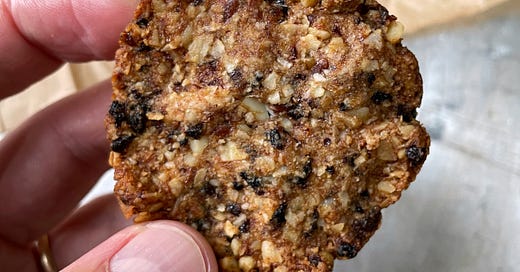A Pro Baker's Power Bar
Roxana Jullapat's Power Oat Bars forgo the usual sticky sweeteners for deliciously whole ingredients and a wallop of sustaining energy
Many, many times, I’ve been lured by a homemade granola bar recipe only to discover, upon closer inspection, that what I’m looking at is actually a cookie. Not that there’s anything wrong with Granola Bars That Are Actually Cookies — I love them — but the promise of the granola bar I have in mind is that of a certain kind of sustenance: a nutrient-dense array of whole ingredients, a quick-fix to prevent a hangriness episode, and a dose of energy that lasts longer than a sugar spike.
The couple of times I’ve tried to create a recipe that meets such a criteria, I quickly understood why some kind of concentrated sweetener — be it honey, brown sugar, or brown rice syrup — is so often used: without it, the thing won’t hold together. Alas, I should have enlisted the help of a professional baker, because it wasn’t until I sat down with Roxana Jullapat’s 2021 cookbook Mother Grains that I finally understood how it could be done.
If you aren’t familiar, Roxana is the co-owner of Friends & Family in Los Angeles, a celebrated bakery and restaurant that expresses her long-held passion for local and seasonal food, which includes the local and heritage grains of the region.
In Mother Grains, her first book, she organizes the recipes by those grains, which include barley, corn, buckwheat, oats, rice rye, sorghum, and wheat. The recipes are wide-ranging and so very appetizing, from savory dishes like Kimchi Fried Barley and Vegan Pozole Verde, to a spectrum of baked goods like Buckwheat Honey Cake, Rye Focaccia, Hatch Chile and Cotija Corn Bread, and Sonora Wheat Croissants.
Additionally, each mother grain gets a deep dive that’s surprisingly absorbing to read — these are my favorite part of the book because I’ve learned so much, and it’s also where the book’s subtitle (“Recipes for the Grain Revolution”) becomes understood:
Sorghum, a versatile and nutrient-rich gluten-free grain most commonly known here in the US as a sweetener but has much broader culinary uses elsewhere in the world, is “the grain of the future.” It’s easy to grow, needs a lot less water than many other grains, and requires a small footprint for a high yield.
Rye is “the cool aunt with fabulous hair” that she also sees as having a ton of potential for the future because, in addition to being so nutritious and culturally important, it revitalizes the soil.
Wheat is “as seasonal as tomatoes or peaches” and needs to be approached outside of its reputation as a blank-canvas subsidy grain, by preserving and rediscovering ancient varieties like einkorn, spelt, and emmer, as well as myriad heritage breeds (over 10,000 of them!) suited for specific environments.
But back to these power bars. Rather than honey, syrup, or granulated sugar, what binds these is dates. This is a method you may know if you’ve ever had a Lara Bar. But unlike a Lara Bar, which can have a crumbly and sometimes greasy texture, these are sturdy little energy pucks that won’t fall apart if you keep one in your pocket.
This is achieved by pressing the mixture into individual molds and baking them, which creates a strong golden crust all around and gets rid of extra moisture, and also using a fortifying cast of nuts, oats, and seeds. The power bars are full flavored and both dense and tender, if that makes sense, and they’re also not very sweet, which is what I like best about them.
Roxana has graciously allowed me to share her recipe, and even let me make a couple tweaks, which are outlined below. I think you’ll find these to be pretty handy to have around.
Roxana Jullapat’s Power Oat Bars
from Mother Grains
Keep reading with a 7-day free trial
Subscribe to Family Friend by Lukas Volger to keep reading this post and get 7 days of free access to the full post archives.





